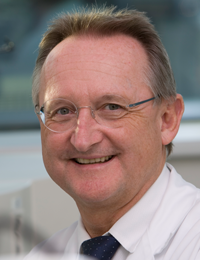
Course handouts are now available
Click here
Come to London

WATCH to find out why
Site updates:
Programme Updates. Programme Overview and - Video Symposium on Challenging Cases now available.
Ridley Medal Lecture
Sunday 14 September | 10.20
Four Decades of Cataract Surgery – Personal Visions for the Future
 Günther Grabner, MD, graduated in medicine in 1974 at the University of Vienna Medical School and started working at the 2nd University Eye Clinic in May 1975. He is the founder of Austria's first Eye Bank (1977). In 1981/1982 he was a corneal and uveitis fellow at the Francis I. Proctor Foundation (UCSF). Following his return he started the cornea and uveitis units of the clinic and was appointed associate professor in 1983. He started a center for “refractive corneal surgery” in 1985 and received a tit.ao.-professorship from the medical faculty in 1990. In January 1993 he was appointed director and full professor at the Eye Clinic of the Paracelsus Medical University in Salzburg, where he has been working since.
Günther Grabner, MD, graduated in medicine in 1974 at the University of Vienna Medical School and started working at the 2nd University Eye Clinic in May 1975. He is the founder of Austria's first Eye Bank (1977). In 1981/1982 he was a corneal and uveitis fellow at the Francis I. Proctor Foundation (UCSF). Following his return he started the cornea and uveitis units of the clinic and was appointed associate professor in 1983. He started a center for “refractive corneal surgery” in 1985 and received a tit.ao.-professorship from the medical faculty in 1990. In January 1993 he was appointed director and full professor at the Eye Clinic of the Paracelsus Medical University in Salzburg, where he has been working since.
He is a member of several national and international scientific societies, vice-president of the Salzburger Ärztegesellschaft, member of "IIIC" and the steering committee of the KPro Study Group and served on the Council of the SOE. A member of the Austrian Ophthalmological Society (ÖOG) since 1975 he was elected permanent scientific secretary for a period of 6 years, re-elected 2005 and president from 2009-2011. He served on the editorial board of: IOC (1983-1997), JCRS (1990–2005), and continues with the JRS and Der Ophthalmologe. He is editor, Klinische Monatsblätter für Augenheilkunde and co-editor, Spektrum der Augenheilkunde.
As to date he has published over 300 articles in peer-reviewed journals, several book chapters, received several awards and given numerous invited lectures and courses at national and international meetings.
His current research interest focuses on corneal and intraocular presbyopia and astigmatism surgery with implants and lasers, development of a system to precisely assess near visual acuity (the Salzburg Reading Desk), keratoprosthesis surgery as well as glaucoma implants and epidemiology (the Salzburg Glaucoma Study) and cataract surgery with the laser in a public hospital.


